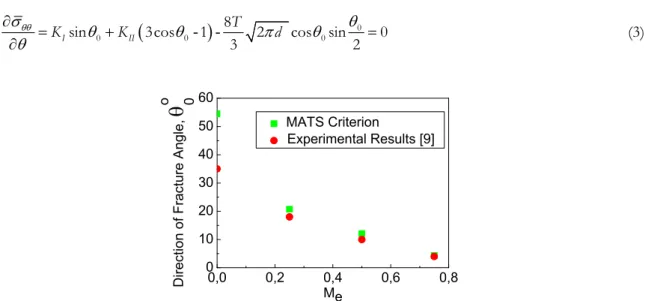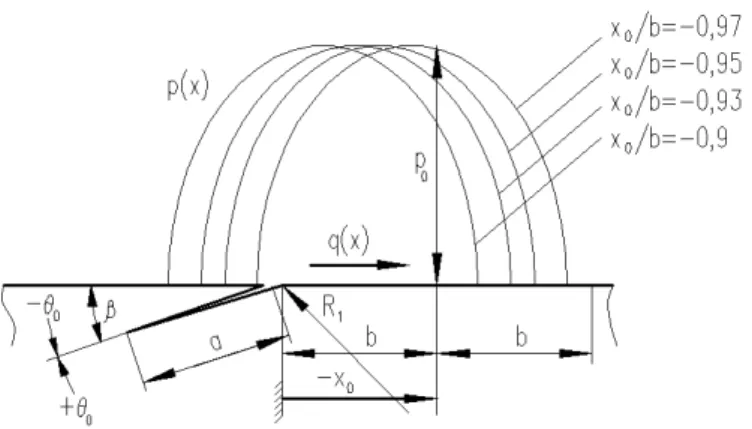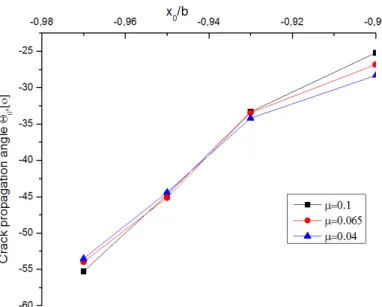Yu.G. Matvienko et alii, Frattura ed Integrità Strutturale, 34 (2015) 255-260; DOI: 10.3221/IGF-ESIS.34.27
255 Focussed on Crack Paths
The concept of the average stress in the fracture process zone
for the search of the crack path
Yu.G. Matvienko, M.M. Semenova
Mechanical Engineering Research Institute of the Russian Academy of Sciences, Russia. ygmatvienko@gmail.com
ABSTRACT. The concept of the average stress has been employed to propose the maximum average tangential
stress (MATS) criterion for predicting the direction of fracture angle. This criterion states that a crack grows when the maximum average tangential stress in the fracture process zone ahead of the crack tip reaches its critical value and the crack growth direction coincides with the direction of the maximum average tangential stress along a constant radius around the crack tip. The tangential stress is described by the singular and
nonsingular (T-stress) terms in the Williams series solution. To demonstrate the validity of the proposed MATS
criterion, this criterion is directly applied to experiments reported in the literature for the mixed mode I/II crack growth behavior of Guiting limestone. The predicted directions of fracture angle are consistent with the experimental data. The concept of the average stress has been also employed to predict the surface crack path under rolling-sliding contact loading. The proposed model considers the size and orientation of the initial crack, normal and tangential loading due to rolling–sliding contact as well as the influence of fluid trapped inside the crack by a hydraulic pressure mechanism. The MATS criterion is directly applied to equivalent contact model for surface crack growth on a gear tooth flank.
KEYWORDS. Crack path; Maximum average tangential stress; T-stress; Mixed mode; Rolling-sliding.
INTRODUCTION
eneral aspects of the concept based on calculation of the average stress over the length of the process zone are described in Refs. [1-6] for a solid with cracks or notches. These references demonstrate an advantage of the critical average stress criterion over the classical elastic and elastic-plastic fracture mechanics criteria because this criterion avoids the confusion of applying the unrealistic continuum mechanics stress singularity to the fracture process zone in the vicinity of the crack (or notch) tip. For example, the failure criterion of the average stress within an effective distance has been successfully employed to relate the apparent fracture toughness in specimens with notches to the fracture toughness obtained from deeply cracked specimens (e.g., [4]). In this case, the effective distance corresponds to the point with a minimum of the stress gradient which requires finite element analysis to obtain the effective distance [5]. It should be noted that the effect of the high stress gradient ahead of the crack/notch tip can be taken into account by means of the theory of critical distance using the stress at some critical distance [6]. The theory of critical distances was very successful in predicting the fracture strength of ceramic materials.
Thus, the concept based on averaging the stress over the fracture process zone length can be successfully applied to cracks or notches. The concept of the average stress has been employed to propose the maximum average tangential stress (MATS) criterion under mixed mode I/II loading for predicting the direction of fracture angle. The effect of the
Yu.G. Matvienko et alii, Frattura ed Integrità Strutturale, 34 (2015) 255-260; DOI: 10.3221/IGF-ESIS.34.27
256
constant term of the series of Williams has been expressed by the parameter T and it is incorporated into the basic criterion equation. To demonstrate the validity of the proposed MATS criterion, this criterion is directly applied to experiments reported in the literature for the mixed mode I/II crack growth behavior.
MAXIMUM AVERAGE TANGENTIAL STRESS (MATS) CRITERION
he tangential crack-tip stress under mixed mode I/II loading can be characterized by the singular (the first order term) and the nonsingular term (the T-stress) in polar coordinate following to Williams [7]
2 2
1 3
cos cos sin sin
2 2 2
2 r KI KII T
(1)
Here, rand are the crack tip coordinates, KIand KII are mode I and mode II stress intensity factor, respectively.
The maximum average tangential stress (MATS) criterion is assumed to be applicable and can be expressed mathematically as follows [8]
0
,
2 2 0
. (2)
This criterion states that a crack grows when the maximum average tangential stress in the fracture process zone
ahead of the crack tip reaches its critical value and the crack growth direction coincides with the direction of the maximum average tangential stress along a constant radius around the crack tip.
Combining Eq. (1) with Eq. (2), the MATS criterion leads to predicting the direction of fracture angle 0[8]
- -
00 0 0
8
sin 3cos 1 2 cos sin 0
3 2
I II
T
K K d
(3)
0,0 0,2 0,4 0,6 0,8
0 10 20 30 40 50 60
MATS Criterion
Experimental Results [9]
Di
rectio
n of Fracture Angle
,
o 0
Me
Figure 1: The predicted and experimental directions of fracture angle for the mixed mode I/II crack growth behavior of Guiting limestone.
VALIDATION OF THE MATS CRITERION
o validate the proposed MATS criterion, Eq. (3) is directly applied to the experimental results [9] for the mixed mode I/II crack growth behavior of Guiting limestone. Different combinations of modes I and II are characterized by a mixity parameter Me
T
Yu.G. Matvienko et alii, Frattura ed Integrità Strutturale, 34 (2015) 255-260; DOI: 10.3221/IGF-ESIS.34.27 257 2 arctan I e II K M K
(4)
The values of Mewere varied through 1 (pure mode I), 0.75, 0.5, 0.25, 0 (for pure mode II).
According to the MATS criterion (Eq. (3)), four parametersKI, KII, T and d at fracture need to be known for each mode mixity. The local strength of this brittle material and the fracture process zone length dare treated as a function of the
tensile strength [8] which is equal to 2 MPa. The fracture toughness Kmat is0.24 MPa m . These values were assumed to
be constant for all mixities.
The fracture trajectories predicted using the MATS criterion (Eq. (3)) are consistent with those observed in the broken specimens under various mode mixities (Fig. 1).
THE SURFACE CRACK PATH UNDER ROLLING-SLIDING CONTACT LOADING
ssuming the singular and non-singular (T-stress) terms are sufficient to characterize the crack tip stress under mode I/II loading in the case of rolling-sliding contact, the tangential stress is written in polar coordinate as
follows [10]
-2 2 2
1 3
( , ) cos cos sin sin sin 2 cos
2 2 2
2
c c
I II xy yy
r K K T
r
. (5)
Here, the tractions xyc and cyy are defined at the crack tip and their distribution is smooth enough along the crack surface. This
equation is valid, if the crack surfaces are loaded with constant pressurep(x y, ). The stress component cyy is then equal to
the –pywhile xyc =−px.
Averaging the tangential stress over the fracture process zone, which is characterised by a critical distanced, the maximum average tangential stress (MATS) criterion leads to the following mathematical expression
0 0
0 0 0
0
cos 2
4 8
sin (3cos 1) 2 ( ) 2 cos sin 0
3 cos 3 2
2
xy yy
c c
I II
K K d T d
(6)
The fracture process zone sizedin the above-mentioned equation can be determined for critical state 0 as follows
2 2 0 2 0
0 0 0 0 0
3 2
sin sin 2 cos cos cos sin
2 2 2
c c
xy yy I II
T K K
d
(7)
In general case, the local strength 0 is dependent on the model of a solid and can be treated for plane strain according to von Mises yield criterion as a property of both the yield stress Yand the T-stress which quantifies constraint in different geometries and type of loading [11, 12]
2
2 2
0 2
1 / 1
1
2 4 1 2
Y Y
Y
T
T T
, (8)
where . .is Poisson’s ratio.
According to Zafošnik et al. [10], the real contact geometry (e.g. gear tooth flanks) can be transformed into a pair of equivalent contacting cylinders with the radii corresponding to curvature radii of analyzed mechanical elements. For small
Yu.G. Matvienko et alii, Frattura ed Integrità Strutturale, 34 (2015) 255-260; DOI: 10.3221/IGF-ESIS.34.27
258
coefficients of friction the distribution of tangential contact loading q(x) due to relative sliding can be estimated with a simple Coulomb friction law within the Hertzian model [13]
( ) x ( )
q x p p x , (9)
where μis the coefficient of friction between contacting elements.
Following loading configurations have been considered to investigate the effect of a moving contact on the crack
propagation angle (Fig. 2). All configurations have the same normal p x
and tangential q x
contact loadingdistributions which are applied at different positions with reference to the crack mouth. The pressure on the crack faces is considered to be equal to that at the crack mouth, and is equal to
2 0 0
( ) y 1
x
p x p p
b
, (10)
where x0/b is moving contact load position (Fig. 2).
Figure 2: Simulation of the moving contact.
The following mechanical properties of carburized steel 16MnCr5 are used in the computational model: Young’s modulus 206
E GPa, Poisson’s ratio 0.3, yield strengthY 2200МPа and fracture toughnessKmat 521MPa m[10].
The Hertzian contact pressure distribution p(x) has the following parameters, namely, maximum value of
0 1779
p MPaand the half-length of the contact areab0.228 mm. The influence of different contact sliding is
simulated with three different coefficients of friction (μ=0.04, 0.065 and 0.1). Initial length of the crack is equal to
0 20
a m with the initial inclination angle towards the contact surface 20o. The computational data published by
Zafošnik et al. [10] is employed in calculation to illustrate the variation of observed parameters in the region of maximum stress intensity factorsKI KI p0 b, KII KII p0 bandTT p0for moving contact load over the crack mouth. The computational results (Fig. 3) determined by the MATS criterion illustrate the variation of crack propagation angle0in the region of maximum stress intensity factors KI, KIIand T-stress for moving contact load over the crack mouth, which is given in terms of a relative position of the loading case with respect to the half-contact width b. It can be seen that the influence of coefficient of friction on crack propagation angle is negligible.
Yu.G. Matvienko et alii, Frattura ed Integrità Strutturale, 34 (2015) 255-260; DOI: 10.3221/IGF-ESIS.34.27
259 Figure 3: Crack propagation angle determined with the MATS criterion.
Figure 4: Crack propagation angle determined with MATS and MTS criteria (coefficient of friction0.1).
Further investigation should be connected with numerical and experimental research to validate the proposed MATS criterion for estimation of crack propagation angles under the rolling-sliding contact loading.
CONCLUSIONS
he maximum average tangential stress (MATS) criterion, based on the concept of the average stress within the fracture process zone, has been proposed for predicting the direction of fracture angle. The effect of the constant
term of the series of Williams has been expressed by the parameter T and it is incorporated into the MATS
criterion. The predicted directions of fracture angle are good consistent with the experimental data for the mixed mode I/II crack growth behavior of Guiting limestone.
The criterion of the maximum average tangential stress, taking into account the non-singular T-stress and the lubricant hydraulic pressure on crack surfaces, is also spread to estimate the surface crack path under the rolling-sliding contact loading. The effect of coefficient of friction and load position on the crack path has been analysed. It is shown that the influence of coefficient of friction on crack propagation angle is negligible. At the same time, there is significant effect of contact load position on the crack propagation angle.
Yu.G. Matvienko et alii, Frattura ed Integrità Strutturale, 34 (2015) 255-260; DOI: 10.3221/IGF-ESIS.34.27
260
ACKNOWLEDGEMENTS
he author acknowledges the support of the Russian Science Foundation (Project N 14-19-00383).
REFERENCES
[1] Dyskin, A.V., Crack growth criteria incorporating non-singular stresses: size effect in apparent fracture toughness, Int. J. Fract., 83 (1997) 191–206.
[2] Matvienko, Yu.G., Local fracture criterion to describe failure assessment diagrams for a body with a crack/notch, Int.
J. Fract., 124 (2003) 107–112.
[3] Matvienko, Yu.G., Erratum: Local fracture criterion to describe failure assessment diagrams for a body with a
crack/notch, Int. J. Fract., 131 (2005) 309.
[4] Kim, J.H., Kim, D.H., Moon, S.I., Evaluation of static and dynamic fracture toughness using apparent fracture
toughness of notched specimens,Mater. Sci. Engng. A, 387-389 (2004) 381–384.
[5] Pluvinage, G., Fracture and Fatigue Emanating from Stress Concentrators, Kluwer Academic Publishers, Dordrecht,
(2003).
[6] Taylor, D., The Theory of Critical Distances, Elsevier, Amsterdam, (2007).
[7] Williams, M.L., On the stress distribution at the base of a stationary crack, J. Appl. Mech., 24 (1957) 109-114.
[8] Matvienko, Yu.G., Maximum average tangential stress criterion for prediction of the crack path, Int. J. Fract., 176
(2012) 113–118.
[9] Aliha, M.R.M., Ayatollahi, M.R., Smith, D.J., Pavier, M.J., Geometry and size effects on fracture trajectory in a
limestone rock under mixed mode loading, Engng. Fract. Mech., 77 (2010) 2200-2212.
[10]Zafošnik, B., Ren, Z., Flašker, J., Mishuris, G., Modelling of surface crack growth under lubricated rolling–sliding
contact loading, Int. J. Fract., 134 (2005) 127–149.
[11]Matvienko, Yu.G., On the cohesive zone model for a finite crack, Int. J. Fract., 98 (1999) L53–L58.
[12]Matvienko, Yu.G., Two-parameter fracture mechanics in contemporary strength problems, Journal of Machinery
Manufacture and Reliability, 42 (2013) 374-381.
[13]Ren, Z., Glodez, S., Fajdiga, G., Ulbin, M., Surface initiated crack growth simulation in moving lubricated contact,
Theor. Appl. Fract. Mech., 38 (2002) 141–149.


